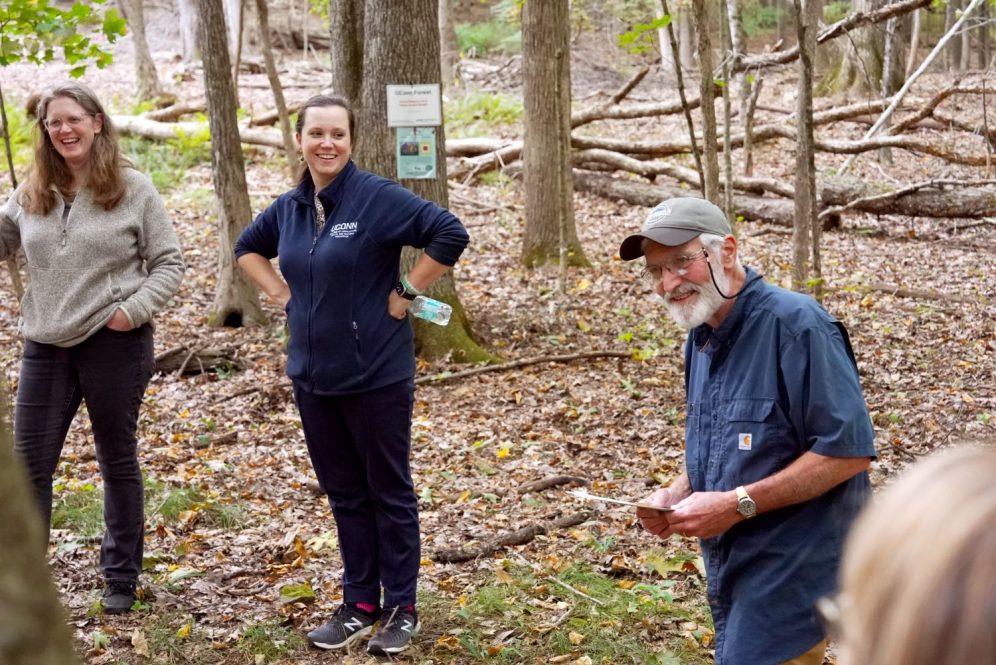A new study updates a gap in data about Connecticut’s private forest owners.
A vast majority, 71%, of Connecticut’s 1.75 million acres of forest are owned by private individuals.
This means understanding private woodland owners’ priorities and interests is critical for state and federal outreach and funding programs.
Ava Smith ’22 (CAHNR), now a social science research specialist at the Arkansas Game and Fish Commission, realized there were limited efforts in the last decade to update information about forest owners in Connecticut.
“It’s important to continuously update our understanding and knowledge of private forest owners so that we can keep up and inform conservation targets,” Smith says.
This survey sought to assess woodland owners’ interest in participating in forest management plans. These are individualized plans that help the owners engage in management practices to support whatever their intentions for their lands are.
“It’s an effort on the part of the woodland owner to give some thought to the future,” says Thomas Worthley, associate extension professor of forest stewardship with UConn Extension. “We know what the land is like now and we know how people use it now, but what is their intent five, ten, fifteen years from now with respect for their land? And the plan is a document that spells out how to accomplish whatever that vision is.”
While they were not able to reach all forest owners, the researchers found some important differences within the group.
This research, by Smith, Worthley, and Chadwick Rittenhouse, associate professor in residence in the Department of Natural Resources and the Environment, was published in Trees, Forests and People.
For example, they found male landowners were more likely to have a management plan in place than female landowners.
Smith says this may be because women have not historically been private landowners, or, it may just be a matter of women having different priorities for their lands as those interested in timber production or hunting.
“Historically private landowners have been predominantly male,” Smith says. “It has been changing though. It could be that female landowners don’t know what avenues to pursue. They don’t necessarily have the same knowledge base or networks that landowners who have had the land for generations and generations do.”

Woodland owners in Connecticut are generally more likely to be interested in the non-commercial benefits that forests provide such as privacy, connecting with nature, protecting wildlife habitat, or preserving a family legacy.
“While the value of wood products is not to be ignored, that’s generally not their highest priority,” Worthley says.
Those with plans were also more likely to be aware of resources available to them and be enrolled in a state program that incentivizes people to keep their land as woodlands, agricultural land, or open space.
The survey showed that those who did not have a plan were generally neutral about developing one, rather than actively against them.
The researchers also found that landowners had priorities beyond what they originally included as options such as pollinator protection.
“To us, it means that there needs to be a level of effort or thought put into future educational programming and represent those varied interests,” Smith says. “If programs are not tailoring to the interests of the landowners, that’s potentially why participating in certain programming is low or landowners are not reaching out to their local service forester to learn more about what they can do to better their lands.”
One of the biggest motivators for conducting this survey now is that within the next decade, the federal and state governments are going to provide funding to private woodland owners to enact climate sustainable practices, but only if they have a management plan in place.
These practices will aim to improve forest resiliency to changes in temperatures and severe weather events or increase carbon sequestration.
“As the public, we are depending on the forest to sequester carbon from the atmosphere,” Worthley says. “The only practical way we have of removing carbon dioxide from the atmosphere is to grow green things as fast as we can.”
This means forest owners can concentrate on which kinds of trees can grow fastest and sequester the most carbon, as one example of a sustainable management practice.
As an extension forester, Worthley will be working diligently over the next few years to connect woodland owners with resources at UConn and beyond to help them get these plans in place.
Private woodland owners can contact UConn Extension, the Connecticut Department of Energy and Environmental Protection Forestry Division, or the National Resources Conservation Service to begin the process of creating a management plan.
This work relates to CAHNR’s Strategic Vision area focused on Advancing Adaptation and Resilience in a Changing Climate.
Follow UConn CAHNR on social media.



